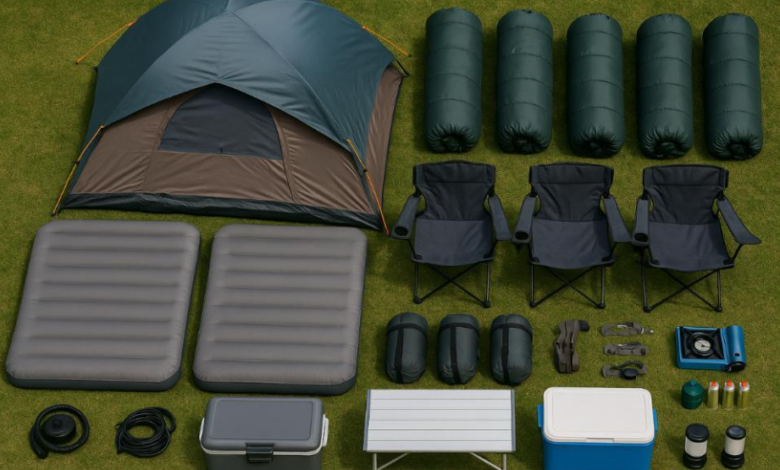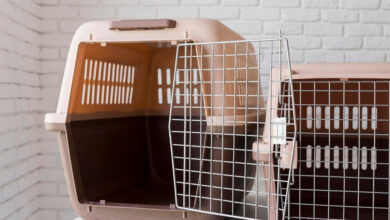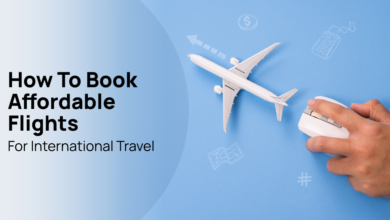Camping Necessities: How to Equip Yourself for $1,000 in Australia

Camping is an experience many parents dream of sharing with their children—a chance to unplug from the digital world, bond with nature, and create lifelong memories as a family. However, for those who’ve never been camping before, it can feel daunting. The sheer thought of needing to buy tents, sleeping bags, stoves, a battery pack for camping, and more can scare off even the most enthusiastic beginners.
But here’s the truth: camping is far less complicated than it seems. With the right guidance and a smart budget, you can gather everything you need for a successful trip without breaking the bank. In this guide, we’ll show you exactly how to build your beginner camping setup for under 1,000 Australian dollars, using accessible gear and reliable recommendations tailored for Australian families.
Choosing the Right Store for Camping Necessities
Before diving into a list of gear, you need to know where to buy it. The key to successful camping necessities prep is finding stores that offer both variety and value.
Anaconda is a well-known chain in Australia that specializes in outdoor and camping necessities. It’s beginner-friendly, has knowledgeable staff, and regularly runs discounts, especially mid-year and at year-end. Anaconda is essentially a one-stop shop where you can grab everything from tents and stoves to sleeping bags and camp furniture. Another budget-friendly option is Decathlon, which has grown in popularity in Australia for its well-designed and affordable outdoor gear. Their tents, chairs, and compact cookware are particularly appealing to new campers who want decent quality without overspending.
For ultra-budget-conscious buyers, Kmart is also worth a visit. While its gear may not be as rugged or long-lasting as Anaconda’s, it offers decent essentials like dinnerware, basic chairs, and lights at very competitive prices. You might also check online retailers or Facebook Marketplace for second-hand deals if you’re just testing the waters.
Essential Camping Necessities on a $1,000 Budget
Let’s now break down all the camping necessities to get you and your family comfortably set up for your first camping trip. Whether you’re building your camping checklist from scratch or upgrading older gear, these items cover everything you need to start strong.
1. Tent
When choosing a camping tent, prioritize comfort and weather protection. A quality tent is essential for keeping your family dry and warm. Opt for a two-layer tent for better waterproofing and airflow, as one-layer tents may lead to condensation issues.
Ease of setup is also important, especially for beginners; look for tents that can be assembled in under 15 minutes, ideally with user-friendly features.
Anaconda offers competitive prices for family-sized tents, such as an 8-person tent typically priced at $439 but often on sale for around $229. Smaller tents for 2-4 people are about $140. Remember, for comfort, it’s best to halve the suggested capacity ratings.
2. Sleeping Arrangements
Adequate sleep is essential for young children during camping trips, as it can greatly affect the experience. While experienced campers may sleep on the ground, beginners should prioritize comfort to maintain energy for daytime activities. Inflatable beds are recommended for their comfort and easy storage, with a queen-size mattress costing about $70—two needed for a family of four totals around $140.
Choose mattresses with reinforced tops to avoid punctures, and consider models with built-in pillows to save space. For limited storage, self-inflating mats are a compact alternative. When selecting an air pump, avoid built-in electric pumps and opt for a separate one that connects to a car’s 12V socket, typically costing around $40. Prioritizing these sleeping arrangements can enhance family camping experiences.
3. Sleeping Bags
When camping in Australia, prepare for cooler nights, even in summer, as temperatures can drop significantly. A 0°C-rated sleeping bag is recommended for comfort and versatility across various conditions, costing about $59 each or $236 for four. These bags can also be unzipped for use as blankets in warmer weather.
Avoid thinner bags rated for 5°C or 10°C unless in hot conditions. Consider bag shape: “mummy” bags are thermally efficient but restrictive, while rectangular bags offer more space. Couples may prefer “double” sleeping bags for shared warmth and efficiency.
4. Camping Chairs
While camping chairs may seem optional, they greatly enhance comfort by providing a dry, supportive place to sit, fostering social interaction around the campfire. Basic foldable chairs cost about $19.99 each, or around $80 for a set of four, with smaller options available for children.
Look for features like cup holders and side pockets for added convenience. If budget permits, director-style chairs with side tables offer extra space for snacks and games.
5. Kitchen Essentials
A well-equipped kitchen is crucial for a successful camping trip. Campsite cooking requires careful planning, but the outdoor experience is rewarding.
For food prep and dining, a long foldable table (around $50) with adjustable legs and an aluminium top is recommended for uneven terrain and easy cleaning. A single-burner gas stove (about $30) is ideal for beginners, especially models with wind guards for breezy conditions. A pack of four gas canisters (around $15) lasts 3 to 5 days, but bringing extra fuel is wise. For dinnerware, consider budget options from stores like Kmart or reusable items from home. Collapsible silicone bowls and stackable plastic dinnerware are space-saving and eco-friendly.
For longer trips or warmer climates, bringing a cooler box or Esky can make a huge difference. Budget models under $50 can keep perishable items cold for 24 hours or more when packed with ice bricks. If camping at powered sites, a small electric cooler is another optional upgrade for those looking to keep milk, meat, or drinks chilled longer.
See also: Best Sri Lanka Transit Visa Vs. Tourist Visa For Your Travel-Line Journey
6. Lighting and Miscellaneous Gear
Proper lighting is crucial for camping. Campsites can become very dark, making illumination essential to prevent trips and falls. Headlamps are indispensable for hands-free tasks like bathroom trips or reading, especially for children. Choose models with multiple brightness settings and a red light mode, costing around $9.99 each.
For tent use, battery-powered LED lights provide ambient lighting for about $17, while gas lanterns offer bright light for cooking but are pricier and require gas. Solar-powered string lights are also beneficial, charging during the day to mark pathways and reduce accident risks at night. Overall, investing in proper lighting gear enhances safety and enjoyment during camping trips.
Don’t overlook the value of small, practical items. Insect repellent, sunscreen, a basic first-aid kit, wet wipes, and garbage bags can drastically improve your comfort and hygiene at camp. They’re easy to forget but make a big difference once you’re out in nature.
Additional Option: A Portable Power Station
Beyond camping necessities and for families with a higher budget or those planning longer, off-grid camping trips, a portable power station can be a game-changer. While not essential for a basic trip, it offers a significant boost in comfort, convenience, and safety—especially when camping in remote areas or for extended stays.
One top-tier option to consider is the Jackery Explorer 1000 v2 Portable Power Station. Priced at $1,299, it’s a serious investment—but for the right family, it can transform the camping experience.
Weighing just 10.8 kg, the Jackery Explorer 1000 v2 Portable Power Station packs 1,070Wh of energy and delivers up to 1,500W continuous power (with a 3,000W surge capacity), enough to run essentials like fridges, fans, lights, laptops, and even a coffee maker. With USB-A and USB-C ports (including up to 100W dual PD fast charging), it supports modern devices with ease. It serves perfectly as a solar battery system for camping, offering clean energy and dependable recharging on the go.
If your family values reliable, clean energy while enjoying nature—or you work remotely and need guaranteed power—this unit offers peace of mind and impressive performance. Though it goes beyond the $1,000 budget, it’s a worthwhile upgrade for those wanting to camp smarter, longer, and more sustainable.
Budget Breakdown of Camping List for Family
| Item | Estimated Cost (AUD) |
| Tent | $229 |
| 2 Inflatable Beds | $140 |
| Air Pump | $40 |
| 4 Chairs | $80 |
| Camping Table | $50 |
| Gas Stove | $30 |
| Gas Canisters (4) | $15 |
| Cooler Box | $50 |
| Sleeping Bags (4) | $236 |
| Headlamps (4) | $40 |
| Camping Light | $17 |
| Total | $927 |
First-Time Camping Location Recommendations in Australia
Choosing the right campsite can make or break your first camping experience. For beginners, it’s best to start somewhere that offers basic facilities without compromising the natural setting.
BIG4 Holiday Parks are excellent for first-timers. These campgrounds are spread across Australia and feature clean amenities such as hot showers, camp kitchens, and sometimes pools or playgrounds. Locations like Byron Bay (NSW), Airlie Beach (QLD), and Port Fairy (VIC) provide beautiful scenery with the comfort of reliable infrastructure and friendly staff.
If you prefer a more nature-immersed experience, national park campgrounds with family or vehicle-accessible areas offer a good balance of wild and manageable. Great options include:
- Wilsons Promontory (VIC): Tidal River Campground: Toilets, hot showers, a small store, wildlife and beach access.
- Booderee National Park (NSW): Green Patch: Toilets and a family-friendly beach setting.
- Lane Poole Reserve (WA): Baden Powell: Spacious sites, toilets, and fire pits along the Murray River, just 1.5 hours from Perth.
Tips for First-Time Campers
- Choose sites within 2–3 hours of home for peace of mind.
- Prioritize locations with toilets and mobile reception.
- Camp in spring or autumn for mild weather and fewer crowds.
- Check fire regulations in advance—a campfire adds to the experience but is often restricted in summer.
Family-Friendly Considerations
If you’re camping with young children, choose sites with nearby toilets, flat ground, and clear boundaries. Parks with open spaces for play, shallow swimming spots, or nature trails are ideal. Some locations, like BIG4 Holiday Parks or national parks with designated family areas, offer both adventure and convenience—helping kids ease into the outdoors with confidence.
Conclusion
Gear and destination matter, but the real magic of camping lies in your willingness to adapt, laugh at mishaps, and soak in the quiet moments together. You don’t need years of experience or a huge budget to enjoy a successful family camping trip. With thoughtful planning and the right camping necessities, it’s entirely possible to get started for around $1,000 AUD.
Begin with the basics, and upgrade over time as camping becomes part of your routine—whether that means investing in better bedding, cooking gear, or portable power like a Jackery generator. Most importantly, camping is about connection to nature, to each other, and to the simple joys of life. From toasting marshmallows to stargazing, the memories you create will far outweigh the gear you bring.




